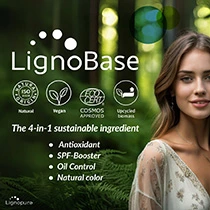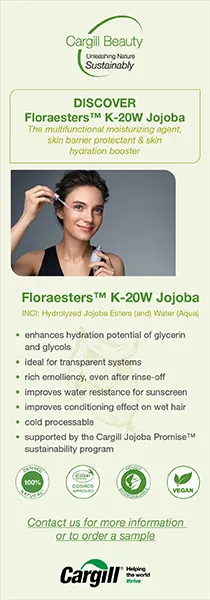Future of healthy aging: AI and nanotech drive breakthroughs in skin longevity

Healthy aging innovations are getting a facelift with the introduction of new technologies, such as artificial intelligence (AI), and addressing the skin at a DNA level. These developments allow companies to meet demands for personalized skin care at a speed and accuracy “never seen before.”
Personal Care Insights speaks with experts from Givaudan, AstaReal, BASF, and Mitra Bio about how they use technology to address healthy aging, the most sought-after ingredients, and what the future of epigenetics might look like.
“Technological advancements are revolutionizing the development and efficacy of anti-aging skin care products,” Peter Ahlm, head of marketing and sales at AstaReal, tells us.
AI “birthing” new ingredients
With the help of AI, techniques such as precision fermentation are “giving birth to new generations of ingredients,” says Mathias Fleury, head of actives at Givaudan Active Beauty.
More powerful technologies allow for new observations from biological and clinical points of view, allowing for efficient evaluation of active ingredients.
“AI helps to identify the most potent ingredients in suppliers’ pipeline, screening thousands of possibilities with a speed and accuracy never seen before. Meanwhile, it can also anticipate the benefits of a specific ingredient or routine over the longer term, thanks to the big data and clinical or biological evidence gathered over decades of investigation,” says Fleury.
“It is now possible to extrapolate the skin aging trajectory over the years based on a few months of clinical studies, demonstrating the interest of preventive aging.”
 LED masks are becoming integral to skin care routines, offering professional-grade treatments at home.Tech for skin care
LED masks are becoming integral to skin care routines, offering professional-grade treatments at home.Tech for skin care
Nanotechnology in ingredient delivery, as nanocarriers enhance the bioavailability and stability of active ingredients, is developing. This ensures deeper skin penetration and improved antioxidant activity.
Ahlm also points to AI-driven personalized skin care, which enables ultra-precise skin diagnostics and personalized product recommendations by analyzing individual skin characteristics, leading to more effective and tailored skin care routines.
Cécile Kalem, launch manager for Beauty Care Solutions Europe at BASF, adds that technology is redefining consumer interaction with skin care. She says nanotechnology and biosensors are future-forward devices that can monitor skin conditions or hormone levels and adapt skin care routines.
Kalem details innovative diagnostic tools, such as AI apps and wearables, that analyze the skin in real time to guide skin care use.
She says AI-powered formulation enables rapid prototyping of personalized serums, maximizing both efficacy and consumer trust. Augmented reality or virtual reality try-ons allow virtual product testing, tapping into environmental sustainability by reducing waste while increasing customer engagement.
Kalem continues that adaptive skin care — smart formulas that respond to environmental stressors such as pollution, climate, and light — are gaining traction.
Ahlm from AstaReal adds that at-home beauty tech devices, such as LED masks and microcurrent tools, are becoming integral to skin care routines, offering professional-grade treatments that stimulate collagen production and improve skin texture.
“These technological integrations are enhancing the efficacy of skin care products, making them more responsive to individual needs and contributing to the advancement of healthy aging solutions,” says Ahlm.
 Consumers gravitate toward personalized, science-backed, and environmentally conscious products.Aging at an early stage
Consumers gravitate toward personalized, science-backed, and environmentally conscious products.Aging at an early stage
The experts point to the rise of ingredients targeting aging pathways at a very early stage.
Tackling healthy aging early protects the extracellular matrix against natural degradation. It also helps the skin function properly, avoiding the formation of spots and protecting and repairing the DNA.
Fleury explains that by controlling the skin’s epigenetic mechanisms, the biological clock and circadian rhythm are being “respected.” He says these topics have seen a massive rise in recent months, with strong scientific demonstration and proven long-term benefits.
Ahlm highlights AstaReal’s astaxanthin active, derived from microalgae such as Haematococcus pluvialis. It is an antioxidant that can neutralize free radicals and protect the skin from oxidative stress.
“Clinical studies have demonstrated that both oral supplementation and topical application of astaxanthin can improve skin elasticity, reduce the appearance of fine lines and wrinkles, and enhance skin hydration,” says Ahlm.
Astaxanthin has antioxidant properties to protect against UV-induced damage and support skin health.
The ingredient also has a synergy with collagen, a popular ingredient in combating the signs of aging. “Combining astaxanthin with collagen hydrolysate has demonstrated synergistic effects in enhancing skin elasticity and reducing signs of photoaging. Clinical studies have shown significant improvements in skin elasticity and barrier integrity after supplementation with this combination,” says Ahlm.
“The application of biotechnology in cultivating microalgae has led to the efficient production of high-purity astaxanthin, ensuring consistency and potency in skin care formulations.”
The healthy aging trend is evolving toward longevity-inspired beauty, where skin care supports long-term cellular health and youth preservation. Marine algae, postbiotics, peptides, collagen, and SPF are widely used to prevent aging.
Ahlm adds that consumers gravitate toward personalized, science-backed, and environmentally conscious products that deliver tangible results, reflecting a holistic approach to healthy aging.
“Preventive care starts earlier, with consumers in their 20s seeking protection before the first wrinkles appear,” details Kalem from BASF.
 Epigenetics is the pattern by which our genes are turned on and off, revealing the skin’s biological age. Epigenetics for aging
Epigenetics is the pattern by which our genes are turned on and off, revealing the skin’s biological age. Epigenetics for aging
Extensive research into epigenetic clocks and their role in skin care has occurred throughout the last decade.
Shakiba Kaveh, CEO of Mitra Bio, details the clocks as algorithms that use epigenetic profiles to arrive at the skin’s biological age. This allows consumers to understand whether they are aging faster or slower than their chronological age, and how fast the aging process goes.
Kaveh explains that epigenetics is the pattern by which our genes are “turned on and off.” Our epigenetic profiles change as we age, from changing diets, sun exposure, and using products and treatments.
She points to a study that was able to reverse the age of skin fibroblast cells by 30 years by temporarily inducing a stem-cell-like state in them before bringing them back. This resets much of the accumulated damage to the skin’s epigenetics.
“This was done in vitro, but it opens the door to treatments that could one day repair skin aging at the molecular level. Biotech start-ups are trying to translate these results into safe and effective in vivo products,” says Kaveh.
As consumers become increasingly conscious about health tracking and healthy aging, there is a demand for accessible data about skin age, health, and response to products and treatments.
“We have invested a lot of research into building an epigenetic skin aging clock, using a gentle and painless approach that collects skin cells with tape strips,” Kaveh says.
Kalem from BASF adds that innovation in healthy aging is no longer “limited to what’s in the jar, but it’s also about how the skin is understood, monitored, and treated.”
“Regenerative boosters inspired by medical aesthetics are taking center stage in epigenetic actives, biomimetic peptides, and cellular reprogramming. Epigenetic skin care science by BASF uses DNA to influence improvements in the look and feel of your skin.”
“AI is used to model novel peptides, boost formulation efficacy, and now plays a pivotal role in accelerating innovation cycles. These advances reflect a major convergence between skin care, wellness, and medtech.”
“Growth factor-inspired actives are no longer science fiction,” Kalem concludes.












